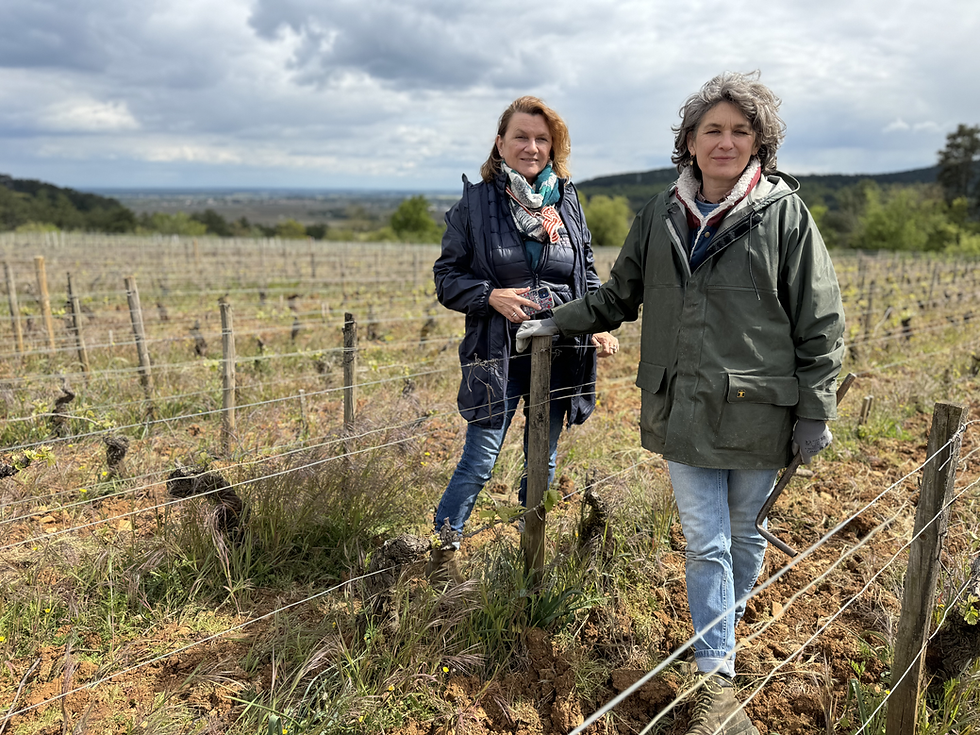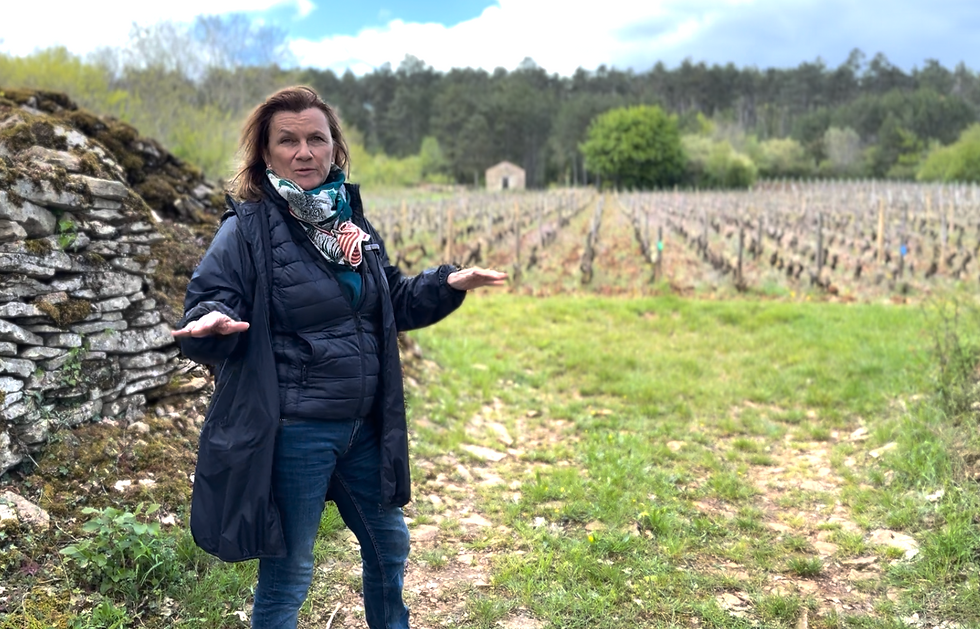LOUIS CHENU PÈRE ET FILLES: FIFTH GENERATION ORGANIC BURGUNDY FROM SAVIGNY-LÈS-BEAUNE
- Candid Wines
- Apr 24, 2023
- 6 min read
Updated: Aug 12
Sisters Caroline and Juliette Chenu continue their family's century-long legacy in Savigny-lès-Beaune, producing certified organic wines imported and distributed exclusively in Illinois through Candid Wines.
Video interviews filmed by Damien Casten in Chicago and in Savigny-lès-Beanue. Updated 8/12/2025
The Domain
Louis Chenu Père et Filles operates 9.5 hectares in Savigny-lès-Beaune, producing approximately 32,000 bottles annually. The estate traces its origins to 1914, when Angel Gay, the sisters' great-great-grandmother, purchased their first parcel in Premier Cru Les Lavières. The domain name translates to "Father and Daughters," reflecting the current family structure where Caroline oversees viticulture and winemaking while Juliette manages sales and communications.

Terroir and Geography
Savigny-lès-Beaune's amphitheater-shaped valley creates distinct microclimates across its 22 Premier Cru sites. The Rhoin river divides the appellation between south-facing slopes and cooler east-northeast exposures. The family owns and farmes Cru on both sides, allowing the estate to present the many expressions of Pinot Noir that are possible within the appellation.
The geological foundation reflects typical Côte de Beaune composition: limestone, clay, and marl, with variations in drainage and stone content affecting individual vineyard character. The estate's holdings span from old vine parcels above the village of Savigny at the highest elevations in the appellation, across the Premier Cru sites and out to the plain that leads to Beaune and the hill of Corton.
Organic Conversion
The estate achieved organic certification in 2006 following a philosophical shift initiated by Caroline and Juliette upon their return home twenty years earlier. Their father initially resisted, remembering the difficulties of pre-chemical viticulture from his youth. However, the conversion solved persistent rot problems that conventional methods couldn't address.
"We managed to handle rot, which we now never have anymore, through organic farming," Juliette notes. The approach produces smaller berries with thicker skins while organic fertilizers provide gradual nutrition rather than sudden nutrient surges. Combined with strategic leaf removal and reduced yields, these practices eliminated quality issues while improving grape health.
Winemaking Approach
Caroline's philosophy emphasizes minimal intervention requiring exceptional grape quality. All fruit is hand-harvested and completely destemmed. Red wine fermentation follows a gentle protocol: brief cold maceration, followed by fermentation at 31°C maximum for several days, with total vatting time of 10-15 days. This restrained approach preserves the aromatic character that defines Savigny-lès-Beaune.
Village wines age in stainless steel to preserve freshness, while Premier Cru wines spend 12-18 months in predominantly used oak barrels. Red wines are bottled unfiltered—a decision influenced by Juliette's experience comparing filtered and unfiltered Gigondas at Château de Trignon. "The difference was very important, and of course the unfiltered one was showing extremely well," she explains.
White wine production involves direct pressing, overnight settling, then fermentation in 20% new oak barrels using indigenous yeasts. Both alcoholic and malolactic fermentation occur in barrel, with wines remaining on lees for one year without bâtonnage. White wines receive gentle diatomaceous earth filtration before bottling.
The Wines
Bourgogne Rouge
The "first red" at Louis Chenu demonstrates all there is to love about this estate. Like all their wines, this is hand-harvested, destemmed, and fermented in stainless steel following the same careful protocols as higher-level wines. What is amazing for a Bourgogne Rouge is that the bulk of this wine is sourced from a stunning single parcel above the village of Savingy that is surrounded by forest. Sitting at a higher elevation than is allowed by the Savigny AOC, this parcel is an introduction to all that is to come as we travel down hill and into the valley.

Savigny-lès-Beaune "Vieilles Vignes"
Village-level blend from three parcels averaging 50-60 years old. Combines deeper-soil concentration from plain sites with hillside elegance. Caroline prefers drinking this wine young when fruit vibrancy remains prominent, estimating 10-15 years aging potential.
Savigny-lès-Beaune Premier Cru "Aux Clous"
Two-hectare south-facing site with exceptional exposure. The name evolved from "clos," indicating historical walled enclosure. Vines range from 35 to 80 years old across varying soil types—clay and limestone with significant stone content at higher elevations. Produces elegant wines with violet aromatics and soft tannins.
This vineyard is cultivated at mid-slope close to the village and adjoins the cemetery. It includes different types of terrain, comprising of deep, red earth on the upper level and stony ground on the remaining three-quarters. The vineyard is perfectly south-facing. These very pleasant, fairly tender and pleasing wines possess a beautiful color. Less full-bodied but more precocious than the Lavières, they develop a violet fragrance and are very feminine. (Domaine Louis Chenu Père et Filles)
Savigny-lès-Beaune Premier Cru "Les Lavières"
The estate's flagship Premier Cru from three separate plots within this 44-hectare site. Mid-slope positioning with limestone subsoil creates mineral complexity. Blending parcels of different ages and rootstocks adds complexity to the final wine. Displays red fruit and violet aromatics in youth, developing gunflint minerality with age.
Les Lavières - The Lavières get their name from the stone found in their sub-soil, which is covered with a very fine layer of stony brown earth (30 cm). This premier cru is very fragrant when young and remains so with age, which is typical of this appellation. It makes a tender, elegant and pleasant wine when young due to its finesse. It gives off several aromas of red fruits and also violet. It remains very firm with age. As it ages, it develops a soil taste that is reminiscent of the smell of gunflint or smoke. It can easily be kept for around fifteen years. (Domaine Louis Chenu Père et Filles)
Savigny-lès-Beaune Premier Cru "Les Hauts-Jarrons"
North-northeast facing vineyard with deeper, sandier soils resembling Beaune-Bressandes. Purchased by Juliette's grandfather 53 years ago, this nearly one-hectare parcel produces wines with greater density and structure than typical Savigny expressions. Candid Wine's Alex McNeely suggests that Les Haut-Jarrons structure and tannic body make it the perfect Savigny cru for Steakhouse wine lists.
Haut Jarrons - The Hauts-Jarrons (Jarrons meaning tree branches) are located in the middle of the slope under the Mont Battois hill heading towards Beaune. Their deep and sandy soil is similar to that of the Beaune-Bressandes. Likewise, the wines are more like those from Beaune than Savigny. Very full-bodied and tannic, they have good aromas but remain closed when young. They require a few years before reaching fullness and are favorable to a long ageing process. (Domaine Louis Chenu Père et Filles)
Savigny-lès-Beaune Blanc "Les Saucours"
The estate's sole white wine, produced from Chardonnay grown in this Premier Cru site. Following direct pressing and overnight settling, fermentation occurs in 20% new oak barrels using indigenous yeasts. The wine undergoes both alcoholic and malolactic fermentation in barrel, aging on lees for one year without bâtonnage. Juliette describes Savigny's Chardonnay as distinctive within Burgundy: "It tends to be rich and has a lovely apple, pear, white flower perfume," noting that white wine production is uncommon in this predominantly red wine village. The mineral-driven style reflects the limestone-rich terroir while maintaining the richness characteristic of Côte de Beaune whites.
Les Saucours : The Savigny whites come from so-called “white” soil, which comprises in part of marl. Only 5% of the Savigny vineyard is made up of white grape varieties (mostly chardonnay). The most favorable ground is situated at the entrance to the village on a slightly sloping hillside facing north (Les Saucours) and at the exit of the village heading towards Bouilland on a hillside this time facing south (Les Vermots). The Savigny-Lès-Beaune white wines are well-structured, dry, quite rounded and are an attractive golden-green color. The main chardonnay variety gives the roundness, the aromas and the finesse. The pinot blanc (around 10%) provides the touch from the vine.(Domaine Louis Chenu Père et Filles)
Market Context
Eric Asimov's June 2022 New York Times coverage positioned Savigny-lès-Beaune as "upward bound," specifically highlighting Louis Chenu Père et Filles as exemplifying the appellation's quality evolution. He highlighted individual Premier Cru expressions—Les Lavières showing "lovely, earth-toned red fruit" and Les Hauts-Jarrons displaying "more structured" character, adding that they represent exceptional value within Burgundy's Premier Cru hierarchy.
Recent vintages available through Candid Wines have produced diverse, but consistently approachable and delicious wines. If you are new to Burgundy, this is a great time to dive into Savingy as Wine Spectator's Vintage Guides for Beaune include: 2022 (96 points), 2021 (94 points), 2020 (95 points), and 2019 (92 points).
Style Profile
Savigny-lès-Beaune produces wines emphasizing elegance over power. "A red wine from Savigny is very often soft, delicate, and elegant," Juliette explains. "They're not very often full-bodied." This approachable style, combined with good acidity supporting long aging potential, makes these wines particularly suitable for restaurant programs seeking food-friendly Burgundy at accessible price points.
The estate's location—five minutes from Beaune, fifteen minutes from Gevrey-Chambertin, ten minutes from Meursault—places it at the center of Burgundy's most prestigious appellations while offering more reasonable pricing than many of its famous neighbors.





Comments